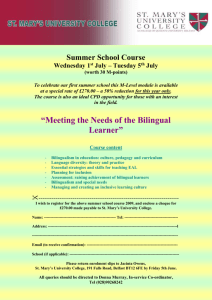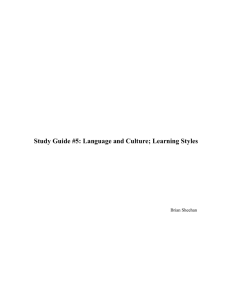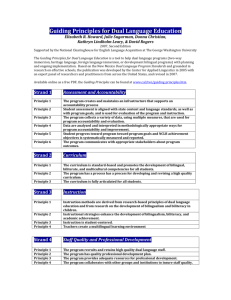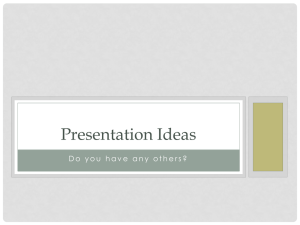Document 12907113
advertisement
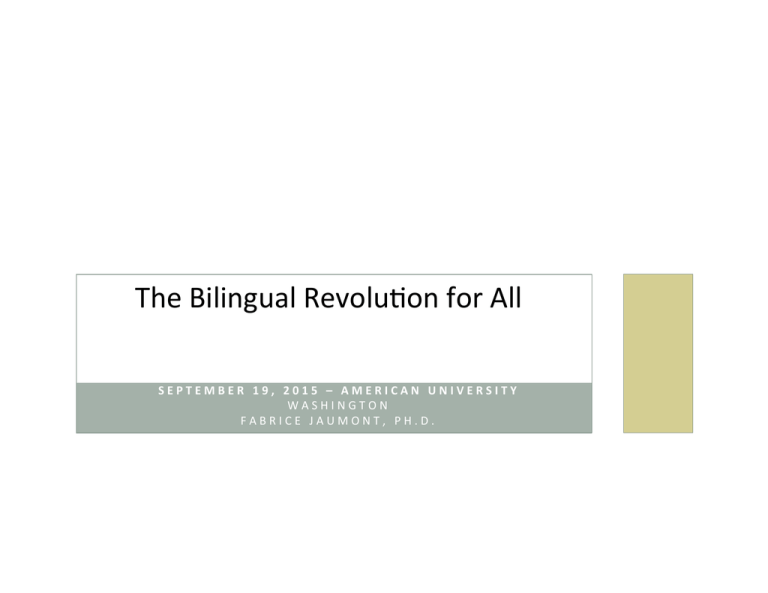
The Bilingual RevoluAon for All S E P T E M B E R 1 9 , 2 0 1 5 – A M E R I C A N U N I V E R S I T Y W A S H I N G T O N F A B R I C E J A U M O N T , P H . D . CONTENT 1 – Why We Need a Bilingual RevoluAon 2 – The Advantages of Bilingualism 3 – Roadmap for CreaAng Dual Language or Language Immersion Programs in Public Schools 4 – What Success Looks Like 5 – Take Home GLOSSARY • DUAL LANGUAGE: A program in which the language goals are full bilingualism and biliteracy in English and a partner language, students study language arts and other academic content (math, science, social studies, arts) in both languages over the course of the program, the partner language is used for at least 50°/D of instrucAon at all grades, and the program lasts at least 5 years (preferably K-­‐12). A dual language program serves both na@ve English speakers and na@ve speakers of the partner language, with neither group making up more than two-­‐thirds of the student populaAon. • FOREIGN LANGUAGE IMMERSION: A dual language program in which students are primarily na@ve English speakers learning a foreign language. The language and academic goals are generally the same as those of a dual language program, however instrucAon Ame in the target language may vary from 30% to 90% of the Ame. 1 -­‐ WHY WE NEED A BILINGUAL REVOLUTION • Because more schools with bilingual educaAon programs are needed • Because these programs can improve schools and empower communiAes in unprecedented ways. • Because being educated in two languages at a very young age can give children a head start in their life. • Because parents can make a difference by starAng dual language or immersion language programs in their communiAes. • Because a call for acAon is needed to bring the advantages of bilingualism to as many children as possible. • Because it is good for business, as the following table shows. RATIONALE FOR CREATING DUAL LANGUAGE OR FOREIGN LANGUAGE IMMERSION PROGRAMS IN PUBLIC SCHOOLS • More and more non-­‐English-­‐speaking families in the U.S. want their children to maintain their heritage language while adapAng to their new American environment. • More and more monolingual English-­‐speaking families value the benefits of bilingualism, and seek quality dual language educaAon programs • Both groups can unite to create successful dual language or foreign language immersion programs in public schools. • Empowering parents to become dual language educaAon advocates for their community can generate posiAve outcome for society as a whole. RATIONALE FOR A COMMUNITY • Create the lifelong gib of a second language to all children in the community who enroll. • A criAcal number of English as a Second Language Learners need dual language instrucAon in order to learn to speak English. • Increase educaAon choice and quality in public school. • Dual Language EducaAon benefits to the whole school community (by gaining some very moAvated parents, adding fund-­‐raising capabiliAes, leveraging the community help build, e.g., becer library) RATIONALE FOR SCHOOL AUTHORITIES A Dual Language Program is a way to leave one's mark, by adopAng the disAncAveness of bilingualism. Benefits for Schools include • access to addiAonal funding from the government, • acAvaAon of an engaged and dynamic parent pool, • new opportuniAes for student enrichment throughout the school, • becer average results on standardized tests • —all of which differenAate the school and make it more appealing for incoming students. 2 -­‐ THE ADVANTAGES OF BILINGUALISM MORE ADVANTAGES OF BILINGUALISM 1 -­‐ INCREASED ACADEMIC OUTCOMES • Dual language students outperform non-­‐dual language students on standardized tests. 2 -­‐ REDUCED DROP OUT RATES • High school students in two-­‐way immersion programs have lower drop out rates than their comparison peers in monolingual se;ngs. 3-­‐ BETTER COGNITIVE FUNCTIONING • Immersion students develop greater cogni=ve func=oning and demonstrate increased a>en=on control, be>er memory and superior problem-­‐solving skills. 4 -­‐ NARROWS THE ACHIEVEMENT GAP • Dual language educa=on can narrow the achievement gap between high-­‐and low-­‐ performing popula=ons. 5 -­‐ FASTER RATE OF LEARNING OF ADDITIONAL LANGUAGES • The experience of becoming bilingual itself makes learning a new language easier. 6 -­‐ GLOBAL OPPORTUNITIES FOR STUDY AND WORK • Being bilingual at an early age can translate into many more opportuni=es to study and work abroad. 7 -­‐ MARKETABLE SKILLS FOR HIGHER SALARIES • In an increasingly global and compe==ve job market, being bilingual and biliterate is an advantage that not only gives access to prized posi=ons, but is also rewarded with higher salaries. 8 -­‐ A POSITIVE SENSE OF SELF-­‐IDENTITY • A dual language educa=on preserves language learners’ sense of pride in the language of their parents. BILINGUALISM RESHAPES THE BRAIN ConAnuous use of two languages is crucial for becer preservaAon of brain structure. Keeping acAvely bilingual makes our brains more efficient at relaying informaAon. Christos Pliatsikas, CogniAve Psychologist at University of Kent. LEARNING A NEW LANGUAGE HELPS KIDS BETTER UNDERSTAND PSYCHOLOGY, DIVERSITY Learning a second language helps children grow up with reduced essenAalist beliefs and prejudice. At the same Ame, it strengthens their creaAve and cogniAve performance. Krista Byers-­‐Heinlein, Centre for Research in Human Development, Montreal 3 -­‐ THE ROAD MAP 1.Community Outreach Create a base of interested families 2. LocaAng a School Find a principal interested in opening a DL program 3. Launching the Program Provide support to the principal to prepare for the launch Road Map credit: EFNY, La PeAte Ecole, the French Embassy, the Downtown French DLP parents group A. COMMUNITY OUTREACH OBJECTIVES IdenAfy 30 interested families, whose children will enter K in opening year: Gather data about target language speaking families in the community: 30 children (for language immersion model) or Children’s years of birth 15 target language speaking families (for a dual language model) School zone & district 15 other families (for a dual language model) Classes need a minimum of 18 students to be viable. School leaders will take project more seriously if more students sign up. This graph suggests 30 children as a good working number. Numbers may vary depending on context. HOW TO IDENTIFY INTERESTED FAMILIES? Email, post flyers, meet with parents at the following places: Religious InsAtuAons Playgrounds Local Businesses Parent AssociaAons Public Schools Private Schools and Daycare Centers Newspapers, Blogs, and Radio B. LOCATING A SCHOOL Get to know the schools Collect data about each school’s mission, potenAal, and needs using first wave of interested parents IdenAfy moAvated families who have connecAons with principals and/or parent coordinators Engage key players Who? Principals, parent coordinators, parent advocates, superintendents, city council members Where? Office of English Language Learners (DOE), Community EducaAon Council, Community Boards Build a raAonale and present it to interested principals Show the benefits for the school and the principal Illustrate the benefits for the community C. LAUNCHING THE PROGRAM Keep promoAng the program Support the principal Organize parent informaAon meeAngs (invite parents and teachers from exisAng DL programs to share their experiences) Support the securing of materials: fundraising, grant wriAng, creaAng curriculum aligned book list Encourage parents to visit the new school and exisAng DL schools Support with hiring of qualified teachers and teacher assistants, as needed Facilitate the sharing of best pracAces from established DL programs 4 -­‐ WHAT SUCCESS LOOKS LIKE • To succeed, DL programs require a solid tri-­‐ parAte partnership ––commitment from schools' leadership, qualified, dedicated teachers, & ceaseless involvement from parents at all levels. • Schools hosAng these programs can benefit from diversity of populaAon they serve & diversity of teaching staff, able to incorporate linguisAc & cultural differences into pedagogy. • Parents from diverse backgrounds & ethnic communiAes can become builders of bilingual educaAon opportuniAes for their children & children of non-­‐naAve speakers. • Heritage communiAes can strengthen linguisAc bond that unite them and reinforcing the sustainability and appropriateness of bilingual programming. GOALS AND CHALLENGES • Difficulty of recruiAng cerAfied bilingual teachers • = incenAve + Professional development opportuniAes • More appropriate educaAonal materials • = translaAon + book purchase + resource creaAon • CreaAng a vision for success, and implemenAng it all the way to college • GOALS = more schools, becer programs, becer teachers, greater access = more opportuniAes for all SOME RECENT EXAMPLES FROM NYC • FRENCH • JAPANESE • ITALIAN • RUSSIAN (parAal list) In New York City, when 15 students who speak the same language and are in the same grade or two conAguous grades, a bilingual class must be established. FRENCH • 11 Public School programs opened between 2007 and 2014 • Serving approximately 1,300 children from Pre-­‐K to 7th grade • IniAated by parents • Half the classes are in French and the other half in English • Each class is made up of 50% French speakers, 50% non-­‐naAve French speakers • Demand conAnues to increase from both naAve and non-­‐naAve French speakers, fostered by strong results and significant media coverage 21 A COMMUNITY’S GOALS • 22 600 children to serve in NYC • enough to create 50 addiAonal programs • Expand to High School • Ensure quality for all DLPs • Recruit/train teachers • Build/buy resources • Private Fundraising necessary ($2.8m target) JAPANESE -­‐ NYC first Japanese-­‐English DLP -­‐ IniAated by parents -­‐ A year’s effort -­‐ StarAng in Sept 2015 with Kindergarten at PS147in Brooklyn -­‐ More info here ITALIAN -­‐ NYC without an Italian DLP? It just doesn’t make sense! -­‐ Goal: NYC first Italian-­‐ English DLP in 2015 -­‐ IniAated by parents + Consulate and IACE -­‐ SAll looking for a school to start in Sept 2015 -­‐ More informaAon here RUSSIAN -­‐ Russian parent organizaAon -­‐ DLP already acAve in several schools in Brooklyn -­‐ Trying to grow new programs in other neighborhood 5. TAKE HOME 1 -­‐ Being bilingual is the new norm. Monolingualism is the illiteracy of the 21st Century 2 -­‐ Being bilingual is not a taboo, nor the privilege of a happy few. 3 -­‐ Bilingualism is rich in cogniAve advancement & beneficial to brain's execuAve control funcAons. 4 -­‐ Early-­‐language acquisiAon through immersion offers new possibiliAes for families who seek to learn and master an internaAonal language. 5 -­‐ Being bilingual means business 6 -­‐ Empowered parents can make a difference 7 -­‐ A bilingual revoluAon has started and it is for our common good. Merci! THANK YOU French Dual Program at PS 84 (Manhacan) Dr. Fabrice Jaumont LinkedIn: FabriceJaumont nyu.academia.edu/FabriceJaumont Twiber @FabriceJaumont fabrice.jaumont@nyu.edu
